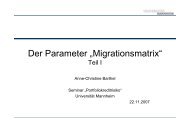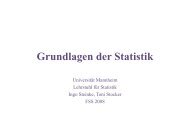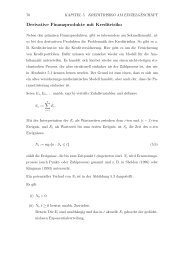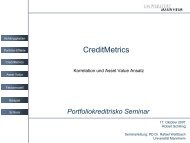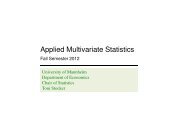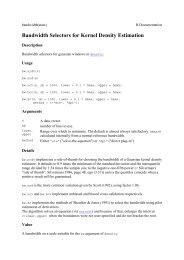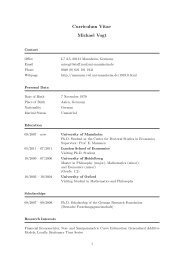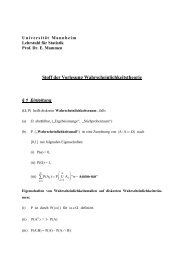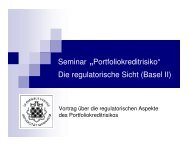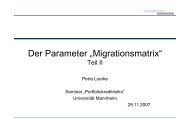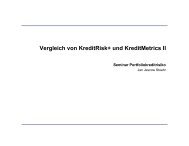Discussion on the paper BOOTSTRAP FOR DEPENDENT DATA: A ...
Discussion on the paper BOOTSTRAP FOR DEPENDENT DATA: A ...
Discussion on the paper BOOTSTRAP FOR DEPENDENT DATA: A ...
You also want an ePaper? Increase the reach of your titles
YUMPU automatically turns print PDFs into web optimized ePapers that Google loves.
choice of an optimal or near-optimal bootstrap approach. The questi<strong>on</strong> how <strong>on</strong>e chooses <strong>the</strong> bootstrap<br />
procedure with <strong>the</strong> best bias-variance tradeoff seems to be ra<strong>the</strong>r unclear. The choice of bootstrap<br />
tuning parameters has been studied, e.g. choice of <strong>the</strong> block size for block bootstrap. But how to<br />
choose data adaptively between several bootstrap procedures seems to be an open research questi<strong>on</strong>.<br />
This requires <strong>the</strong> study of new double bootstrap or crossvalidati<strong>on</strong> techniques, perhaps inspired by<br />
<strong>the</strong>oretical work <strong>on</strong> data-adaptive smoothing parameter selecti<strong>on</strong> in n<strong>on</strong>parametric curve estimati<strong>on</strong><br />
or by recent <strong>the</strong>oretical progress in model selecti<strong>on</strong>.<br />
We also would like to comment fur<strong>the</strong>r <strong>on</strong> <strong>the</strong> bias comp<strong>on</strong>ent of <strong>the</strong> bootstrap error. Our discussi<strong>on</strong><br />
takes <strong>the</strong> linear process bootstrap (LPB) as an example. The LPB introduced by McMurry and<br />
Politis (2010) uses tapered and banded autocovariance matrix estimators of <strong>the</strong> whole (univariate)<br />
data stretch and i.i.d resampling of appropriately standardized residuals to generate bootstrap observati<strong>on</strong>s.<br />
C<strong>on</strong>sistency of <strong>the</strong> LPB was established in McMurry and Politis (2010) for <strong>the</strong> sample mean.<br />
There it was shown that MA processes can be resampled without estimating <strong>the</strong>ir coefficients explicitly.<br />
This is usually d<strong>on</strong>e by numerical optimizati<strong>on</strong> or by <strong>the</strong> innovati<strong>on</strong> algorithm. Both procedures<br />
are much more involved than estimating for example AR coefficients. Validity of <strong>the</strong> LPB, including<br />
a multivariate versi<strong>on</strong>, is shown in Jentsch and Politis (2011). They show that <strong>the</strong> multivariate LPB<br />
works also for spectral density estimati<strong>on</strong>, but that, in general, it fails for sample autocovariances.<br />
With <strong>the</strong> previous discussi<strong>on</strong> in mind, this is not surprising, because <strong>the</strong> LPB is designed to capture<br />
<strong>the</strong> covariance structure of <strong>the</strong> underlying process and <strong>the</strong> limiting distributi<strong>on</strong> of sample autocovariances<br />
is known to depend also <strong>on</strong> higher order characteristics of <strong>the</strong> true DGP. Even in <strong>the</strong> univariate<br />
case and under assumed linearity, this is still <strong>the</strong> case. However, as Jentsch and Politis (2011) show,<br />
c<strong>on</strong>sistency of <strong>the</strong> LPB holds for univariate, causal and invertible linear processes for higher order<br />
statistics as e.g. autocovariances. At first sight, this may seem to be surprising, because c<strong>on</strong>trary to<br />
fully n<strong>on</strong>parametric bootstrap methods as e.g. <strong>the</strong> block bootstrap, <strong>the</strong> LPB mimics by c<strong>on</strong>structi<strong>on</strong><br />
<strong>on</strong>ly <strong>the</strong> sec<strong>on</strong>d order structure of <strong>the</strong> DGP and not its entire dependence structure. But by taking<br />
a closer look and particularly in comparis<strong>on</strong> to <strong>the</strong> prominent autoregressive sieve bootstrap [cf. <strong>the</strong><br />
discussi<strong>on</strong> in Kreiss, Paparoditis and Politis (2011)], which is str<strong>on</strong>gly related to <strong>the</strong> LPB approach,<br />
this result fits in <strong>the</strong> existing literature. Heuristically, <strong>the</strong> LPB remains valid in this case due to a<br />
triangular shape of <strong>the</strong> matrix A that (approximately) transforms <strong>the</strong> vector of residuals (e1, . . . , en) ′<br />
by pre-multiplicati<strong>on</strong> to <strong>the</strong> vector of observati<strong>on</strong>s (X1, . . . , Xn) ′ . Thanks to <strong>the</strong> triangular shape of<br />
A and under invertibility, this matrix fits properly toge<strong>the</strong>r asymptotically with <strong>the</strong> Cholesky matrix<br />
that is involved in <strong>the</strong> bootstrap algorithm. Eventually, this implies c<strong>on</strong>sistency for <strong>the</strong> LPB in this<br />
case. In summary, we see in this example that c<strong>on</strong>sistency c<strong>on</strong>siderati<strong>on</strong>s for bootstrap are often<br />
much more involved and complex as <strong>on</strong>e would expect from an analysis using bootstrap compani<strong>on</strong><br />
processes.<br />
To summarize, we think that this review <strong>on</strong> bootstrap for dependent data gives a very detailed and<br />
informative discussi<strong>on</strong> of <strong>the</strong> state of <strong>the</strong> art. In our opini<strong>on</strong> future work is needed for an understanding<br />
of <strong>the</strong> bias-variance performance of bootstrap procedures. Fur<strong>the</strong>rmore, this knowledge must be used<br />
to develop efficient data adaptive methods that choose between different bootstrap procedures.<br />
References<br />
[1] Jentsch, C. and Politis, D.N. (2011). The multivariate linear process bootstrap. Preprint.<br />
[2] Kreiss, J.-P., Paparoditis, E. and Politis, D.N. (2011). On <strong>the</strong> range of validity of <strong>the</strong> autoregressive<br />
sieve bootstrap. Annals of Statistics (in press).<br />
[3] McMurry, T.L. and Politis, D.N. (2010). Banded and tapered estimates for autocovariance matrices<br />
and <strong>the</strong> linear process bootstrap. Journal of Time Series Analysis 31, 471–482.<br />
2



